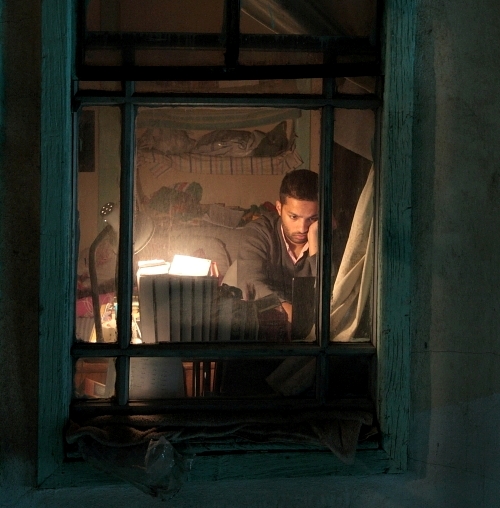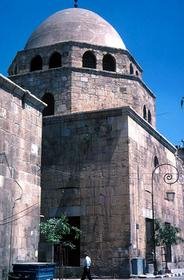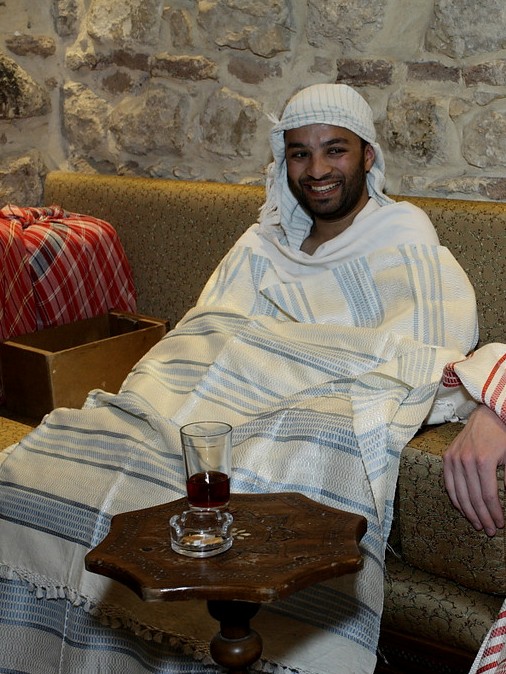Ali Khan “At the Hamam”
Posted by Joshua on Friday, April 17th, 2009
“At the Hamam” – Dispatch from Damascus 20 (15/04/09)
By Ali Khan
Photos by Ketan Gajria
I had been delaying going to the hamman for a long time. However, this month at university was slightly more challenging than usual and so after the exam I decided it was a good time to visit. We all met at my house and after a few phone calls and a short discussion on the merits of the various hammams we decided to go to the Hammam Al Malik Al Zahir. The hammam is next to the Umayyad Mosque and so we strolled over, enjoying the balmy spring weather but secretly dreading the advent of the hot weather. Unfortunately for us but I suppose fortunately for Syria, tourists season has begun and we had to negotiate our way through hoards of colour coordinated backpacks and baseball caps. At the northwest corner we walked through a pack of Iranians, men in round collar shirts with suits and women in flapping chadors. A few of the younger ladies stopped to look at crockery and cutlery displayed in a shop but judging by the number of shopping bags they were already carrying, they had shopped enough. The group was going to Seyyida Ruqayya’s shrine because it was Thursday night and they were going to partake in the recitation of the Dua-e Kumail. Imam Ali taught the Prayer to Kumail ibn Ziad Nakha’I. Kumail was a disciple of Imam Ali and some traditions even state that several esoteric truths of the faith were also revealed to him. He was killed at the age of ninety by Hajjah ibn Yusuf Thaqafi. My great uncle wrote that the central theme of the Dua “is the unshakeable belief that Allah has promised to forgive all sins except the sin of setting up equals to Himself, whenever any of His creatures tormented by conscience turns towards him in a spirit of penitence, and whosoever seeks forgiveness from his Lord is given not only forgiveness but also prosperity and security in this world and the Hereafter.” Independent of religion, the Arabic prose of the prayer is majestic and reaffirms for me the sublime yet vast nature of the language.
We turned into a side street and entered a small door next to the Zahiriyya Library. It was already dark outside and there was warm yellow glow around the door. We probably looked very lost and as I wandered over to the fountain to grab a handful of the multi-coloured pastilles, a bear of a man, in an extremely tight t-shirt and a pink sarong walked over to us and pointed to a corner where we could sit. The sitting area was elevated slightly. There were long benches along the walls with cushions on the seat and drawers below to store out clothes. The mosaic beneath the water in the fountain sparkled in the light of the chandelier as it swayed gently because of the wind coming in through the door. The dome above us was covered in red, green and gold decorative motifs. Above us was another balcony with wooden rails and one of the workers bobbed in and out of sight as he said his evening prayers. There were little tables and wooden cabinets with the traditional inlay work of mother of pearl in various nooks and crannies. In one corner was a barber applying the finishing touches of some kind of facemask on a customer. I strained to see his face in the mirror and saw his face covered in a lime green paste. His eyes were accentuated by the green treatment and he looked like a frog that was very pleased with itself. Later, it turned out that he was not one of the Syrian shabab but an East Asian tourist.
The hammam was designed and built by Ibn al Hussain al Akiki in 985 AD and then was bought by Saeed ibn al Zahir Baybers, a Mamluk king in 1277. The house attached to the hammam was converted to a Madrassa.
The man who had seated us earlier came over with a pile of sarongs and asked us to change our clothes. We looked around and seeing the confused look on our faces he said that we had to change there. There were many other people in the foyer, children were running around the fountain and the workers had gathered around the refrigerator, which had a big Pepsi logo. The man opened the sarong and held it up while we changed and in a deft movement he wrapped me in the sarong when I took of my trousers. We were then ushered into the actual hammam. On our right were people, wrapped up in towels, smoking argileh and drinking tea, having finished with their hammam session. We walked into the anti-room of the main hammam and another man with a green sarong came and handed us each a bowl with olive oil soap, shampoo and a sponge. We then walked through another door and I caught one my friends grimacing at the sight of old hairy men in wet red sarongs sitting around chatting loudly while in one corner a man lay on the floor and one of the attendants, with tattoos on his arms, pounded his back. We went further in and found a quiet corner. Ketan, who had been to a hammam earlier explained how the whole process functioned. The main chamber had a vaulted roof with little rooms one either side separated by small arched doors. Along the walls were water basins with hot and cold water. We found the steam room, which was just about big enough for the three of us but I think only about one and a half of the Syrians we had seen earlier would have been able to sit comfortably in it. After a short while it became a bit uncomfortable and so we trooped out, only to find a middle aged Syrian man rubbing soap on his tummy. Unfortunately he had also decided to discard his sarong and was wandering around in a white pair of Y fronts. Not the prettiest sight! Meanwhile a group of Iranian men had wandered in were rubbing soap on each other. I heard one of them mutter that he did not want the ‘tattooed man’ to touch him. We sat around for a while and went back to the steam room and then we hesitantly proceeded to wait in line for the massage. By then I think we all were getting a bit sick of the clammy air and we left. In the next room the same man held up a fresh sarong as we discarded the wet ones.
Outside a group of young Khalijis, people from the Gulf countries had wandered in. They always look very conspicuous, not only because they are generally darker than Syrians but also because their sense of dress is very loud. Most of them wore leather motorcycle jackets with the Ferrari, Lamborgini, Maserati and Rothmans logos and some of them also wore huge designer sunglasses, even though it was nighttime and they were inside and this coupled with their gelled, or I should say glued, hair made them look like very menacing giant flies. We clip clopped in our wooden sandals to our corner and a man came and swaddled us in towels and tied one on our heads. Finally, he opened pink and blue stripped togas, for lack of a better word, and added that as the final layer. He then brought us tea and tried to make us believe that we had ordered an argileh though we successfully managed to dissuade him. On the opposite side of the room a young man had just walked in with his very young son and was trying to persuade him to take of his clothes but the little boy kept saying that his mama had already given him a bath that day. Eventually he relented and one of the attendants tied a little sarong on him and brought him miniature wooden clogs. By now we had dried off and finished our tea. The barber came to inquire whether we needed any services but we politely refused.
On the way back home we came across a huge procession in Bab Touma. I had forgotten it was Easter. A marching band led the procession and the tune they were playing seemed very familiar. Later I realised that the statue of Jesus and the Virgin Mary was being carried along Straight Street to the theme song of Francis Ford Coppola’s film God Father. Another friend had told me that he had also heard the same tune at a funeral but I had refused to believe him. Behind the musical band were troupes of young girls and boys dresses in scout uniforms. Apparently the scarves around their necks signified the Church they came from. The adults watching the procession had come out in their Sunday best or at least the Syrian version of it. The men seemed to have added extra gel and the ladies seemed to have searched their closets for the most risqué clothes they had. Hidden amongst them I spotted a handful of old ladies dressed in black and wearing headscarves with a thin lace veil covering their face. We met up with a couple of other friends. One of them had been to a Jewish Passover and had sung songs in Arabic with his hosts, most memorably one in which they counted from one to thirteen because each number had a particular significance. Another friend had gone to Mustapha Ali’s gallery to attend a Flamenco concert. I think it suffices to say that there is still a lot of room for improvement as far as the performing arts are concerned in Syria. As I walked home that night my friend mentioned to me that even though the many people in world identify Syria with conflict and violence, not that they do not exist at all, that night we had seen Christians, Jews and Muslims practicing their faith within the four walls of the old city without impinging or intruding on the others. She added that obviously it would be naïve to believe that there is complete harmony amongst the three faiths here but for one evening, we did see that it is possible to co-exist peacefully with one another.
Happy Easter and until Next week Ma’as Salaama!





Comments (11)
أمنيّة said:
i loved the second photo..
and the article as well.
April 17th, 2009, 2:23 pm
pamela said:
Nice to see you , did you come out of the Hammam feeling tingly clean ? or just sweaty ?
April 17th, 2009, 8:02 pm
Ali said:
Hello Pamela! I felt like I had to go take a shower straight away! Not tingly clean at all! I hope that people don’t go to hammams to get clean!
April 18th, 2009, 7:42 am
Yossi (AKA Rumyal) said:
Ali,
Interesting post as usual. Good to see your photo and your “natural habitat” 🙂 Spending a lot of time here one gets used to being cloaked in anonymity. Attaching an image to your voice is a nice change. The Passover song you were told about is “Ekhad Mi Yodea?” The text is actually a mixture of Hebrew and Aramaic (like other Passover texts).
http://www.hebrewsongs.com/song-echadmiyodea.htm
My wife had to go to the “mikveh” (Jewish Hamam) before we got married, in order to get “purified”. She too headed straight to the bath afterwards 🙂
April 18th, 2009, 8:06 am
Yossi (AKA Rumyal) said:
Majid,
I thought it was a matter of personal accountability for me to not joke around as long as the Palestinians are under occupation… but.. you twist my arm… check this out:
April 18th, 2009, 8:38 am
majid said:
That’s a good one YOSSI.
I also liked the song with numbers in comment # 3. Amazingly, I read exactly the same ‘themes’ somewhere else.
However, if someone asks you to sing number 40, I’m sure you can find lots like: the forty days Moses spent on the mountain or the forty years in the desert. But you may also want to know that this earth will exist no more that is it will be destroyed by Him if it becomes deficient of 40 individuals who have the likeness of Abraham. And they are always anonymous roaming the earth. He (the ONE) keeps it in existence because of them and because He loves them so much and for no other reason.
April 18th, 2009, 10:16 am
Yossi said:
Majid,
40 righteous people out of 6 billion is a very low bar for humanity to meet. HE is indeed very merciful and generous 🙂
April 19th, 2009, 1:08 am
norman said:
to All,
Look at this,
I am realy amazed on how much i missed while studying in Damascus in the seventies,
Damascene Perversion: Syria’s Underwear Sellers Peddle Sex and Seduction
Maid’s costumes, musicial negligee and remote-controlled underpants: You’d be surprised what you can find in a Damascus market. Syrian underwear is now so famous that it is exported throughout the Middle East — and Palestinian women, reportedly, have the wildest taste. (…)
April 19th, 2009, 1:33 am
Alex said:
http://www.tayyar.org/Tayyar/News/PoliticalNews/ar-LB/128844832293068865.htm#
Jumblatt supposedly said about the Maronites: “What was a bad seed remains bad seed”
Then he gave the Sunnis their share of criticism. (I won’t translate)
جنبلاط يفسّر اكثر ويقول: “الإنتخابات الي حتصير مش رح يتغيّر شي جوهري، مصيبتنا بالشوف إنّو بطلّنا لائحة لإنو رجعت النعرة الإنعزالية، ما هوي الجنس العاطل بيبقى جنس عاطل مع الأسف. سعد الحريري هلّق جرّب فينا، طمعّوا لغطاس وصلنا لهون، بدنا نجرّ[ نعالجها بهاليومين، والاّ بدّي سكّر اللايحة ضدّ دوري شمعون وغطاس خوري”.
April 19th, 2009, 1:49 am
Alex said:
Wolf Blitzer and Jeffrey Feltman at Syria National Day Reception
http://www.huffingtonpost.com/steve-clemons/wolf-blitzer-and-jeffrey_b_188565.html
Yesterday evening, I wanted to pay my respects to a fellow blogger and lover of the arts, Imad Moustapha – who also happens to be the Ambassador of Syria to Washington.
I got a snapshot at that Mandarin Hotel party of what incredible impact Barack Obama has had in Washington.
In a Harry Potter sense, Syria has for nearly a decade been “the nation whose name could not be spoken.” We have had walls dividing our diplomatic efforts within Washington — and in my view it’s time that we re-read Barack Obama’s tremdendous campaign-presented speech “A World Without Walls” and try to live that sort of reality within Washington itself.
And it’s beginning to happen.
Wolf Blitzer, anchor of CNN’s Situation Room, stayed for a great long time and met not only Moustapha and his entourage but many others at the party. And then — punctuating the change in the DC game — Acting Assistant Secretary of State for Near Eastern Affairs and former US Ambassador to Lebanon Jeffrey Feltman was there, along with State Department Middle East watcher Nicole Shampaine and Frederic Hof — who is staffing George Mitchell’s Middle East efforts.
Amazing actually. This is a dramatic change in tone and posture since the departure of the George W. Bush administration.
Others at the party were the Boston Globe’s Farah Stockman, CNN’s Elise Labott, Ambassador of Yemen to the US Abdulwahab Abdulla Al-Hajjri, Middle East Institute President and former US Ambassador to Pakistan Wendy Chamberlain, Algerian Ambassador to the US Abdallah Baali, New School professor Alon Ben-Muir, former Colin Powell State Department Advisor and now AAAS International Programs czar Norman Neuriter and his AAAS international policy colleague Vaughn Turekian, and many other interesting journalists, think tank types, and then those trade association, lawyers and consultants looking to cash in on the rapidly changing Syria-US tone.
Also enjoying the scene were the Ambassadors of Turkey, Iraq, Lebanon, Morocco, Quatar, Oman, Malta and Lybia, as well as Charge D’affairs of Jordan, Saudi Arabia, and Bahrain.
— Steve Clemons
April 19th, 2009, 1:50 am
Alex said:
This would be quite interesting if true
http://all4syria.info/content/view/7304/73/
Assafir claims Al-Siddiq was arrested in the UAE.
توقيف زهير الصدّيق في الشارقة متخفّياً بجواز سفر مزوّر؟
طباعة أرسل لصديق
علي الموسوي : السفير
19/ 04/ 2009
ذكرت مصادر مطلعة لـ«السفير»، أنّ ثمة معلومات تتحدث عن توقيف الشاهد السوري زهير محمد سعيد الصدّيق في إمارة الشارقة بدولة الإمارات العربية المتحدة حيث كان يعيش متخفّياً بجواز سفر مزوّر.
وقد جاء التوقيف بناء لطلب من الدولة السورية في إطار التعاون الوثيق بينها وبين السلطات في دولة الإمارات.
وكان المحقّق العدلي الرافع يده عن قضيّة اغتيال الرئيس رفيق الحريري القاضي صقر صقر، قد استردّ مذكّرة التوقيف الغيابية التي أصدرها سلفه القاضي إلياس عيد بحقّ الصدّيق، وهو الإجراء اليتيم بحقّه من قبل القضاء اللبناني، الذي توجّهت موفدته القاضية جوسلين ثابت إلى فرنسا عندما كان يعيش الصدّيق في كنفها ، لاستجوابه ولم توفّق في مسعاها، كما أنّ فرنسا في عهد رئيسها السابق جاك شيراك رفضت طلب لبنان بتسليم الصدّيق، على الرغم من أنّ رئيس الجمهورية السابق إميل لحود تعهّد بعدم تطبيق عقوبة الإعدام بحقّه، مع أنّ عقوبته القصوى لن تصل إلى هذه الدرجة، وإن كان وقع جرمه كبيراً لقيامه بتضليل التحقيق، والافتراء على الضبّاط الاربعة المحتجزين باتهامات ثبت أنّها باطلة وأهملها التحقيق الدولي.
April 19th, 2009, 1:52 am
Post a comment